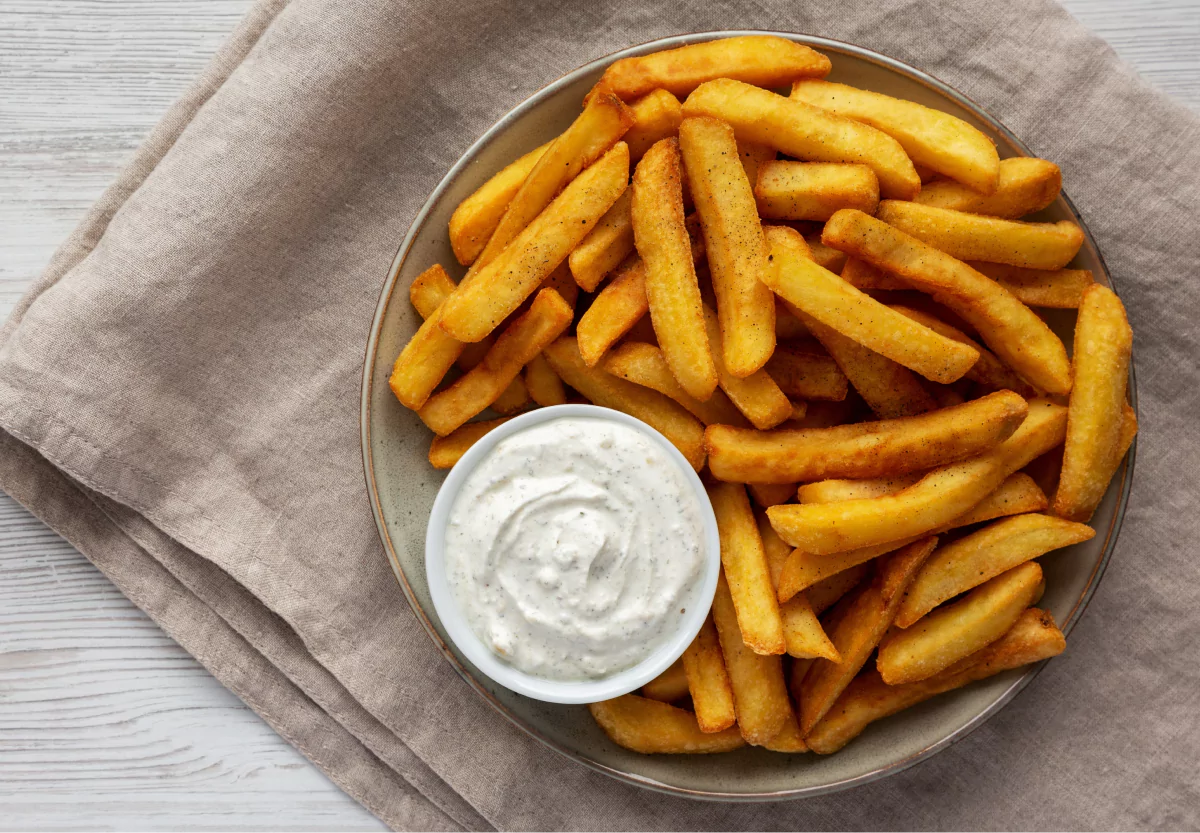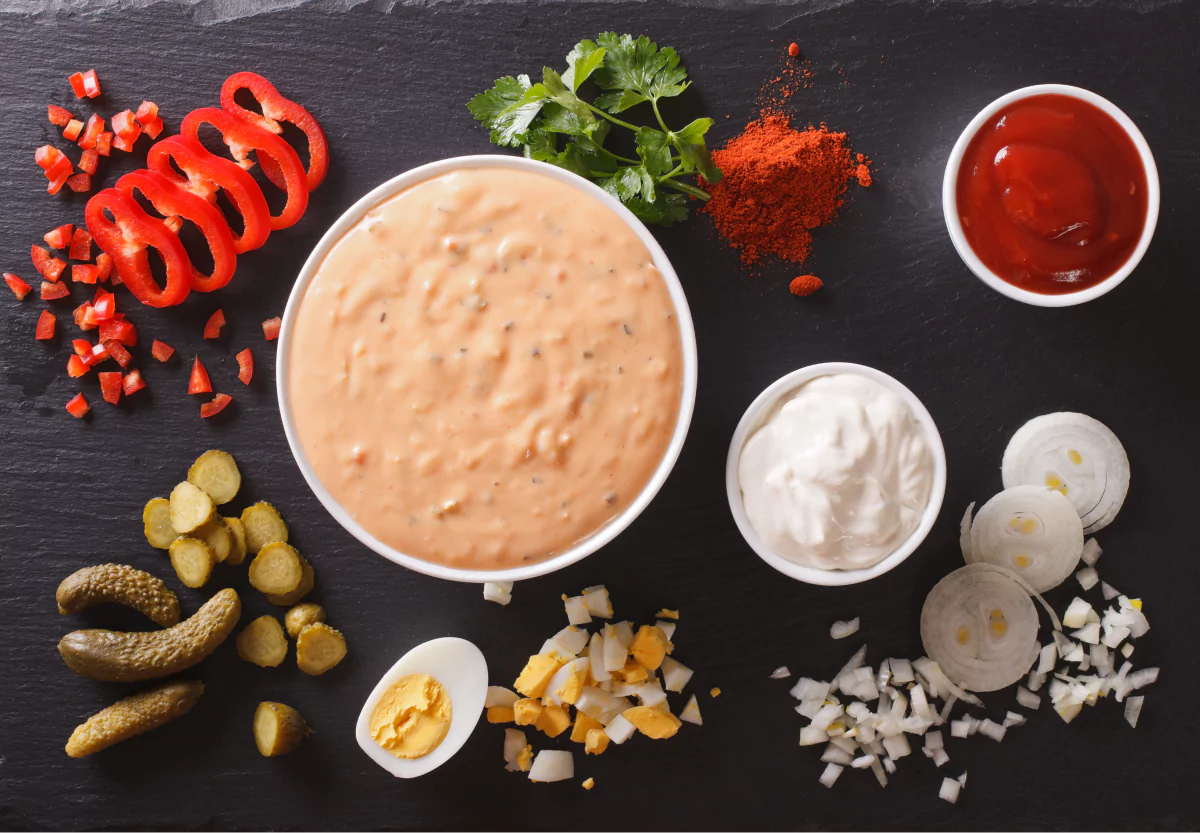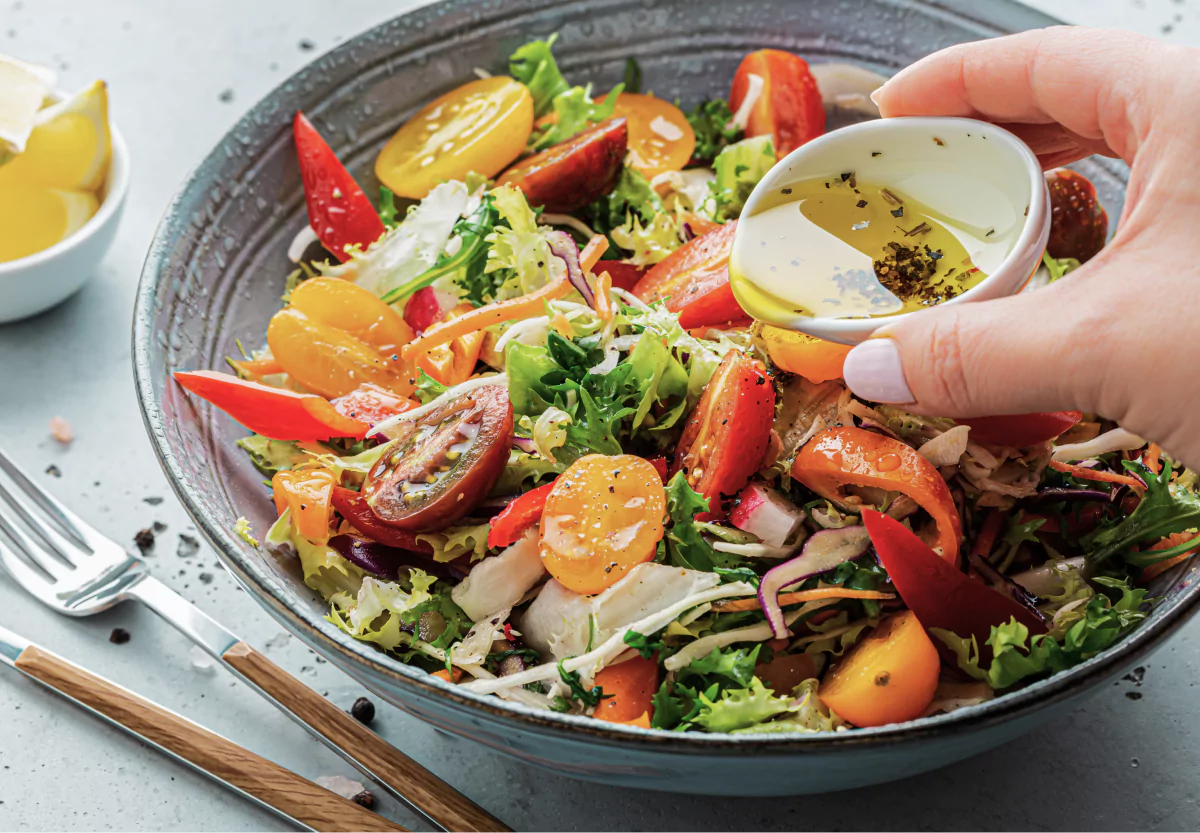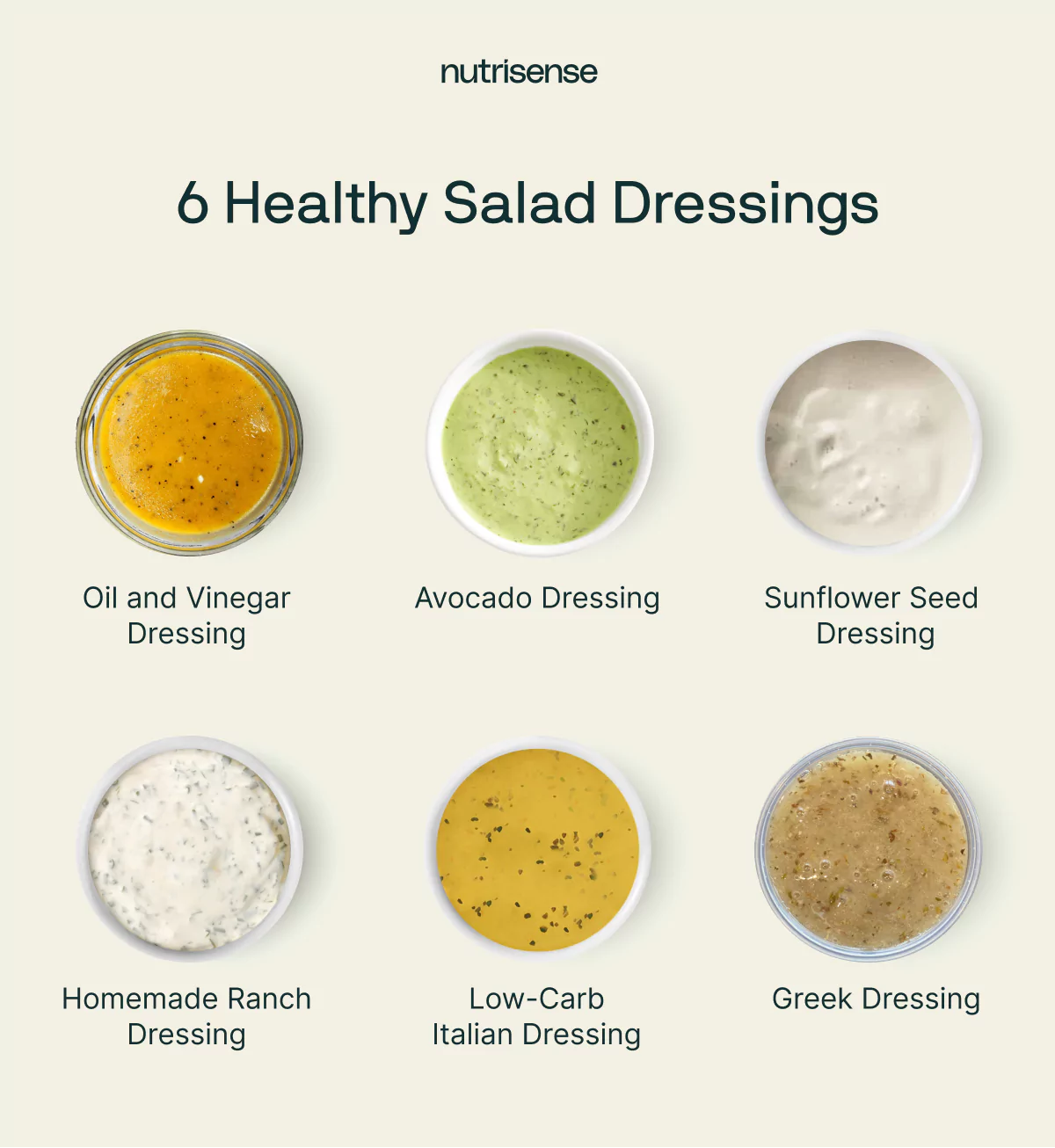How to Make Salad Dressing Healthy: A Helpful Guide

Key Takeways
Salad is something most of us assume is healthy. You start with mixed salad greens, add some vegetables, protein, and sprinkle in some cheese and you’re almost there!
Then, to top it all off—you reach for your dressing. But wait! Before you gamble with the nutritional fate of your freshly-prepared salad, stop and ask yourself: did you read the ingredients?
The truth is, not all salad dressings are created equally. Some dressings harbor high amounts of sugar, sodium, and various additives. It would be a shame to let a carefully crafted salad be dragged down by an unhealthy dressing.
Luckily, we’re here to help. We’ve got all the information you need to take your salads to the next level—read on for our breakdown of unhealthy dressings, best store-bought alternatives, and dietitian-recommended choices.
The Importance of Choosing Healthy Salad Dressings

Why bother yourself with the ins and outs of salad dressing? Well, the unfortunate truth is: your choice of dressing could make or break your salad.
OK, maybe not entirely make or break. But, depending on your particular health goals, your choice of dressing can have quite an impact.
When it comes to determining the health content of different dressings, what should we be looking at? For starters, World Health Organization recommends a diet with the following criteria:
- A daily caloric intake that’s appropriate for your needs
- Limited daily fat intake, especially saturated fats
- Limited daily sodium intake
- Limited daily sugar intake
While the debate on sodium intake continues and links between saturated fat and health are still controversial, there’s no question that too much added sugar can usher in many negative health effects.
5 Unhealthiest Salad Dressings

From preservatives to artificial sweeteners, many store-bought salad dressings contain chemical additives that may have negative effects on overall health. Let’s take a closer look into the nutritional makeup of some common store-bought dressings to see what really makes a dressing “unhealthy.”
The nutritional information provided here suggests a serving size of two tablespoons for each dressing.
1) Caesar Dressing
- Calories: 160
- Fat: 17g
- Saturated fat: 3g
- Sugars: 1g
- Sodium: 356 mg
You’re probably not surprised to find this creamy, cheesy classic making the list for unhealthiest salad dressings. Topping the list when it comes to sodium and fat content, this dressing might serve better as an occasional treat, rather than a daily mainstay.
Often made using soybean or canola oil, store-bought versions of this dressing might not be your best bet for health.
2) Ranch Dressing

- Calories: 129
- Fat: 13g
- Saturated fat: 2g
- Sugars: 1.4g
- Sodium: 270 mg
Another creamy standby, ranch dressing may not be the best influence for your salad. In common ranch preparations, you’re likely to find soybean oil, sodium benzoate, and monosodium glutamate (MSG).
3)Blue Cheese
- Calories: 146
- Fat: 15g
- Saturated fat: 2.5g
- Sugars: 1g
- Sodium: 192mg
Another creamy dressing—what are the odds? Sadly it’s no coincidence that with a creamy, milky texture, often comes a higher fat and sodium content in commercial dressings.
In most cases, blue cheese dressing is made using soybean oil and common preparations may also contain preservatives and artificial food coloring.
4) Thousand Island

- Calories: 114
- Fat: 11g
- Saturated fat: 1.5g
- Sugars: 4.6g
- Sodium: 289 mg
Here’s another rich, flavorful dressing that, while not as calorie-rich and fat-dense as other creamy dressings, still manages to hold its own. No slouch when it comes to sugar, fat, sodium, and calories, we have Thousand Island dressing.
It’s not shocking, really, given that the classic recipe for this condiment includes both ketchup and mayonnaise. Common preparations may contain soybean oil and other preservatives.
5) Russian Dressing
- Calories: 107
- Fat: 7.9g
- Saturated fat: 0.7g
- Sugars: 5.3g
- Sodium: 340mg
Topping the list for sugar content and sodium, we have Russian dressing. While the American Heart Association recommends an upward limit of 2,300 milligrams of sodium daily (and an ideal limit of under 1,500 milligrams), two tablespoons of Russian dressing alone can make up nearly a quarter of your daily intake.
Like many others on this list, Russian dressings are often made from soybean oil and may also contain other additives.
Store-Bought vs. Homemade Salad Dressings

Chances are, you already know this, but remember that “store-bought” can be a big part of the problem when it comes to salad dressings because of poor quality ingredients, additives and sugars. So why not try making your own salad dressing?
Before we get into our dietitian-recommended options, let’s see why homemade is so much better. Here’s a quick side-by-side look at some common dressings, comparing the store-bought version to a homemade recipe.
Balsamic Vinaigrette
- Store-bought ingredients: canola oil, soybean oil, extra virgin olive oil, water, balsamic vinegar, distilled vinegar, sugar, salt, garlic, spice, onion, red bell pepper, xanthan gum, paprika (for color).
- Homemade ingredients: extra virgin olive oil, balsamic vinegar, honey, sea salt, black pepper, garlic, dijon mustard.
Why Homemade Wins
Many store-bought varieties of oil-and-vinegar dressings will opt for cheaper or more processed oils relatively higher in omega 6 polyunsaturated fats such as canola, cottonseed, or soybean. Though these oils do contain some amount of monounsaturated fats, choosing olive oil or avocado oil may boost healthy fat content even more.
Here, the homemade recipe ditches the canola and soybean oil, in favor of only using extra virgin olive oil. Then, in place of added sugar, honey is used to achieve the same sweetening effect without the downsides.
Caesar Dressing

- Store-bought ingredients: soybean oil, canola oil, water, egg yolks, extra virgin olive oil, salt, distilled vinegar, parmesan cheese, Worcestershire sauce, lemon juice concentrate, spices, garlic, onion, natural flavor, xanthan gum, anchovy.
- Homemade ingredients: extra virgin olive oil, Greek yogurt, sea salt, black pepper, parmesan cheese, Worcestershire sauce, dijon mustard, freshly squeezed lemon juice, garlic, anchovy paste.
Why Homemade Wins
Again we see the homemade recipe sticking to extra virgin olive oil—always a solid choice. Then, we use Greek yogurt in place of egg yolks, reducing cholesterol and fat in your Caesar salad dressing.
And finally, the homemade recipe uses freshly squeezed lemon juice in favor of concentrate. Fresh juice is, naturally, less processed than concentrate and may do a better job of preserving certain vitamins and nutrients in the fruit.
Blue Cheese Dressing
- Store-bought ingredients: soybean oil, water, blue cheese chunks (water, blue cheese, palm oil, Sodium and Calcium caseinates, salt, lactic acid, cellulose gum, Sodium phosphates, Potassium sorbate, xanthan gum, locust bean gum), distilled vinegar, salt, sugar, buttermilk powder, egg yolk, maltodextrin, modified food starch, whey, phosphoric acid, xanthan gum, yeast extract, color added, Sodium benzoate, Potassium sorbate, Calcium disodium edta, spice, natural flavor, Disodium inosinate, Disodium guanylate.
- Homemade ingredients: blue cheese crumbles (milk, cheese cultures, salt, enzymes, Pencillium Roqueforti and cellulose), buttermilk, plain Greek yogurt, white vinegar, garlic powder, salt, pepper.
Why Homemade Wins

Just take a look at the difference in length between the store-bought ingredients and homemade! Simply by using blue cheese crumbles with minimal processing, we’re cutting out palm oil and a whole laundry list of different additives.
Then, just like we did with the homemade Caesar dressing, we’re swapping out the egg yolks for plain Greek yogurt. And lastly, by keeping to a simple list of ingredients, we can say goodbye other chemical preservatives and additives.
Ranch Dressing
- Store-bought ingredients: soybean oil, water, sugar, egg yolk, salt, buttermilk, natural flavors, spices, dried garlic, dried onion, distilled vinegar, phosphoric acid, xanthan gum, modified food starch, Monosodium glutamate, Disodium phosphate, Potassium sorbate, Sodium benzoate, Calcium disodium edta.
- Homemade ingredients: avocado oil mayonnaise, Greek yogurt, white vinegar, parsley, dill, chives, garlic, sea salt, onion powder, black pepper, unsweetened almond milk.
Why Homemade Wins
First, we lose the soybean oil and add Greek yogurt and white wine vinegar in place of both the egg yolk and the buttermilk. And of course, once again, by going homemade, we’re ditching the additives.
These are just a few of the many classic dressings that can easily be reimagined and turned from a guilty pleasure, to a healthy standby.
6 Dietitian-Recommended Healthier Salad Dressings

Now onto the healthier end of the spectrum. Using the same criteria, we’ll take a look at some healthy salad dressing options out there that you can use to add a little flavor to your salad.
Here are a few quick and easy recipes recommended by Nutrisense dietitian Heather Davis, MS, RDN, LDN, that anyone can make at home:
1) Classic Oil and Vinegar
It doesn’t get any simpler than this. Choose a high-quality oil like extra virgin olive oil or avocado oil and some acid such as apple cider vinegar, lemon juice, or balsamic vinegar or vinaigrette and blend to taste. You can also throw in some herbs and pepper for a little extra zing.
As we mentioned above, while this classic dressing is typically much healthier as an option, it’s important to remember that many store-bought varieties of oil-and-vinegar dressings are not as healthy as they look! Make sure to read the ingredients list of your dressing of choice.
2) Avocado Dressing
This simple recipe from Love and Lemons is ready in minutes. Blend all ingredients until creamy, then transfer to a jar.
- 1 ripe avocado, pitted
- ¾ cup water
- ¼ cup extra-virgin olive oil
- 3 tablespoons lemon juice
- 1 tablespoon fresh dill
- ½ garlic clove
- ½ teaspoon sea salt
- Freshly ground black pepper
Avocados are a nutrient-dense and healthy option, rich in potassium, magnesium, and vitamin E. They pack a powerful monounsaturated fat punch as well.
3) Sunflower Seed Dressing
Do you ever wish your dressing had some protein to contribute? This one does! This Creamy Sunflower Seed Dressing not only gives your salad a vitamin E and magnesium bump, but has around 4 grams of protein per 4 tablespoons per serving.
Place all the sunflower seed dressing ingredients into your high-powered blender and blend on high until smooth. Store in a sealed jar in the fridge for up to a week.
- ½ cup toasted sunflower seeds
- ¾ cup water
- Juice from 1 lemon
- 1 tablespoon miso, use gluten-free soy sauce instead, if needed
- 1 clove garlic
- Optional: a pinch of cayenne
- ¼ teaspoon salt
4) Greek Salad Dressing

Another great recipe from Love and Lemons, this one takes a healthier spin on Greek dressing. Simply whisk together all ingredients and enjoy!
- ¼ cup extra-virgin olive oil
- 3 tablespoons red wine vinegar or apple cider vinegar
- 1 garlic clove, minced
- ½ teaspoon dried oregano, more for sprinkling
- ¼ teaspoon Dijon mustard
- ¼ teaspoon sea salt
- Freshly ground black pepper
5) Homemade Ranch Dressing
As we mentioned earlier, store-bought ranch dressing is not the healthiest option out there when it comes to salad dressing. But, if you’re looking for a healthier version of this store-bought favorite, look no further. Wholesome Yum has a great option—and it’s low-carb to boot.
- 1 cup mayonnaise (we suggest an avocado mayo)
- 1/2 cup sour cream
- 2 teaspoons lemon juice
- 2 teaspoons dried parsley
- 1 teaspoon dried dill
- 1 tsp Dried chives
- 1/2 teaspoon garlic powder
- 1/2 teaspoon onion powder
- 1/2 teaspoon sea salt
- 1/4 teaspoons black pepper
- 1/4 cup unsweetened almond milk
Whisk all ingredients together. Add the almond milk last, gradually, until you reach desired consistency. Since this dressing might work best with a little pre-refrigeration prior to eating, you might want to plan slightly ahead. You can store it in the fridge for up to 10 days.
6) Low-Carb Italian Dressing
A simple, keto-friendly homemade alternative from Seeking Good Eats still delivers all the flavor of your traditional Italian dressing. You can whisk or shake until blended and it’ll be ready to go in five minutes.
- 1 cup olive oil
- 1/2 cup apple cider vinegar
- 3 tablespoons parmesan, finely grated
- 2 tablespoons Italian seasoning
- 1 tablespoon lemon juice
- 1 teaspoon garlic, minced
- 1/4 teaspoon onion powder
- 1/4 teaspoon garlic powder
- 1/2 teaspoon salt
- 1/2 teaspoon pepper
How to Make Salad Dressing Healthy

How can you keep your salad healthy without sacrificing flavor? Here are some pointers when it comes to healthy homemade salad dressings. Best of all, you can make these dressings in advance with minimal prep time and even keep them on hand for meal prep during the week.
Common Salad Dressing Ingredients to Avoid
- Cheap industrial seed oils, such as: soybean oil, canola oil, cottonseed oil, and corn oil
- Potentially harmful preservatives, such as: Sodium benzoate and Potassium benzoate
- Higher amounts of added sugar
- Artificial coloring agents, such as tartrazine, caramel color, and various food dyes
For fats, opt for healthier oils such as extra virgin olive oil, avocado oil, and sesame oil.
Find Your Ideal Salad Dressing with Your Nutrisense Dietitian

Simply by tweaking the recipe and swapping in healthier alternatives, you can see how easy it is to take high-calorie, high-fat, sodium-dense dressings—loaded with sugar and preservatives—and turn them into light and delicious toppings on your salad and veggies. But it doesn’t have to stop at salad dressing!
With a Nutrisense dietitian, you can work to find the foods, diets, and exercise routines that work for you. Get specialized, detailed advice to help you reach your health goals and start living your best life.
Find the right Nutrisense programto turn insight into progress.
Go Beyond Glucose Data with Nutrisense
Your glucose can significantly impact how your body feels and functions. That’s why stable levels are an important factor in supporting overall wellbeing. But viewing glucose isn't enough. Nutrisense, you’ll be able to learn how to use your body's data to make informed lifestyle choices that support healthy living.
One-to-one coaching
Sign up to access insurance-covered video calls to work with a glucose expert: a personal registered dietitian or certified nutritionist who will help tailor your lifestyle and diet to your goals.
Monitor and measure what matters
With the Nutrisense CGM Program, you can monitor your glucose with health tech like glucose biosensors and continuous glucose monitor (CGM)s, and analyze the trends over time with the Nutrisense App. This will help you make the most informed choices about the foods you consume and their impact on your health.
Find your best fit
Ready to take the first step? Start with our quiz to find the right Nutrisense program to help you take control.

Heather is a Registered and Licensed Dietitian Nutritionist (RDN, LDN), subject matter expert, and technical writer, with a master's degree in nutrition science from Bastyr University. She has a specialty in neuroendocrinology and has been working in the field of nutrition—including nutrition research, education, medical writing, and clinical integrative and functional nutrition—for over 15 years.




